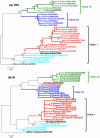Reassortment and mutations associated with emergence and spread of oseltamivir-resistant seasonal influenza A/H1N1 viruses in 2005-2009
- PMID: 21483816
- PMCID: PMC3069057
- DOI: 10.1371/journal.pone.0018177
Reassortment and mutations associated with emergence and spread of oseltamivir-resistant seasonal influenza A/H1N1 viruses in 2005-2009
Abstract
A dramatic increase in the frequency of the H275Y mutation in the neuraminidase (NA), conferring resistance to oseltamivir, has been detected in human seasonal influenza A/H1N1 viruses since the influenza season of 2007-2008. The resistant viruses emerged in the ratio of 14.3% and quickly reached 100% in Taiwan from September to December 2008. To explore the mechanisms responsible for emergence and spread of the resistant viruses, we analyzed the complete genome sequences of 25 viruses collected during 2005-2009 in Taiwan, which were chosen from various clade viruses, 1, 2A, 2B-1, 2B-2, 2C-1 and 2C-2 by the classification of hemagglutinin (HA) sequences. Our data revealed that the dominant variant, clade 2B-1, in the 2007-2008 influenza emerged through an intra-subtype 4+4 reassortment between clade 1 and 2 viruses. The dominant variant acquired additional substitutions, including A206T in HA, H275Y and D354G in NA, L30R and H41P in PB1-F2, and V411I and P453S in basic polymerase 2 (PB2) proteins and subsequently caused the 2008-2009 influenza epidemic in Taiwan, accompanying the widespread oseltamivir-resistant viruses. We also characterized another 3+5 reassortant virus which became double resistant to oseltamivir and amantadine. Comparison of oseltamivir-resistant influenza A/H1N1 viruses belonging to various clades in our study highlighted that both reassortment and mutations were associated with emergence and spread of these viruses and the specific mutation, H275Y, conferring to antiviral resistance, was acquired in a hitch-hiking mechanism during the viral evolutionary processes.
Conflict of interest statement
Figures




References
-
- Bright RA, Medina MJ, Xu X, Perez-Oronoz G, Wallis TR, et al. Incidence of adamantane resistance among influenza A (H3N2) viruses isolated worldwide from 1994 to 2005: a cause for concern. Lancet. 2005;366:1175–1181. - PubMed
-
- Deyde VM, Xu X, Bright RA, Shaw M, Smith CB, et al. Surveillance of resistance to adamantanes among influenza A(H3N2) and A(H1N1) viruses isolated worldwide. J Infect Dis. 2007;196:249–257. - PubMed
-
- Hurt AC, Ernest J, Deng YM, Iannello P, Besselaar TG, et al. Emergence and spread of oseltamivir-resistant A(H1N1) influenza viruses in Oceania, South East Asia and South Africa. Antiviral Res. 2009;83:90–93. - PubMed
Publication types
MeSH terms
Substances
Associated data
- Actions
- Actions
- Actions
- Actions
- Actions
- Actions
- Actions
- Actions
- Actions
- Actions
- Actions
- Actions
- Actions
- Actions
- Actions
- Actions
- Actions
- Actions
- Actions
- Actions
- Actions
- Actions
- Actions
- Actions
- Actions
- Actions
- Actions
- Actions
- Actions
- Actions
- Actions
- Actions
- Actions
- Actions
- Actions
- Actions
- Actions
- Actions
- Actions
- Actions
- Actions
- Actions
- Actions
- Actions
- Actions
- Actions
- Actions
- Actions
- Actions
- Actions
- Actions
- Actions
- Actions
- Actions
- Actions
- Actions
- Actions
- Actions
- Actions
- Actions
- Actions
- Actions
- Actions
- Actions
- Actions
- Actions
- Actions
- Actions
- Actions
- Actions
- Actions
- Actions
- Actions
- Actions
- Actions
- Actions
- Actions
- Actions
- Actions
- Actions
- Actions
- Actions
- Actions
- Actions
- Actions
- Actions
- Actions
- Actions
- Actions
- Actions
- Actions
- Actions
- Actions
- Actions
- Actions
- Actions
- Actions
- Actions
- Actions
- Actions
- Actions
- Actions
- Actions
- Actions
- Actions
- Actions
- Actions
- Actions
- Actions
- Actions
- Actions
- Actions
- Actions
- Actions
- Actions
- Actions
- Actions
- Actions
- Actions
- Actions
- Actions
- Actions
- Actions
- Actions
- Actions
- Actions
- Actions
- Actions
- Actions
- Actions
- Actions
- Actions
- Actions
- Actions
- Actions
- Actions
- Actions
- Actions
- Actions
- Actions
- Actions
- Actions
- Actions
- Actions
- Actions
- Actions
- Actions
- Actions
- Actions
- Actions
- Actions
- Actions
- Actions
- Actions
- Actions
- Actions
- Actions
- Actions
- Actions
- Actions
- Actions
- Actions
- Actions
- Actions
- Actions
- Actions
- Actions
- Actions
- Actions
- Actions
- Actions
- Actions
- Actions
- Actions
- Actions
- Actions
- Actions
- Actions
- Actions
- Actions
- Actions
- Actions
- Actions
- Actions
- Actions
- Actions
- Actions
- Actions
- Actions
- Actions
- Actions
- Actions
- Actions
- Actions
- Actions
- Actions
- Actions
- Actions
- Actions
- Actions
Grants and funding
LinkOut - more resources
Full Text Sources
Miscellaneous

